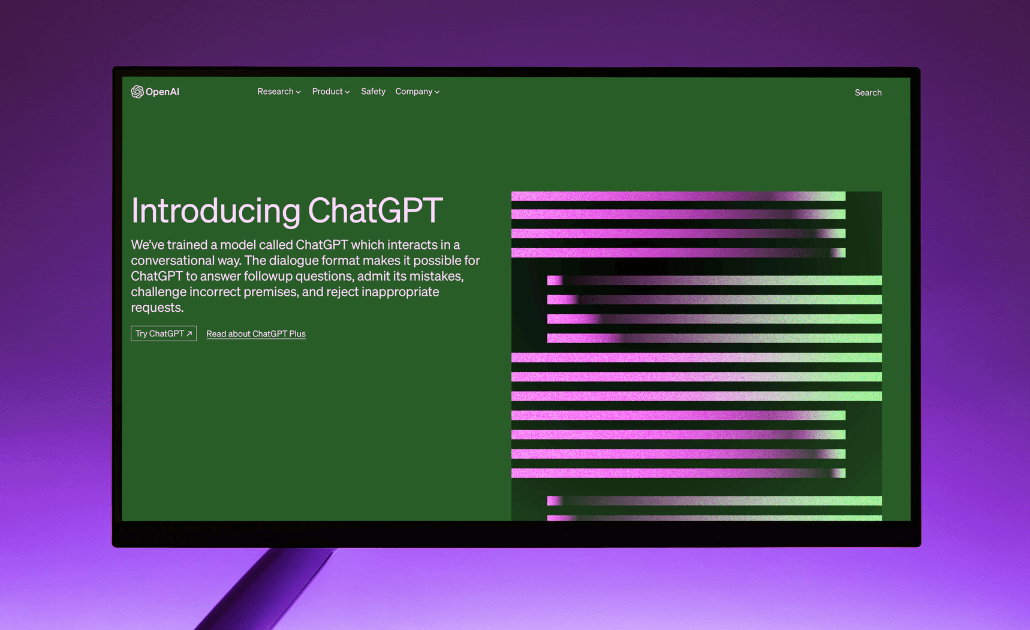
Every now and then, a new technology comes along that has the potential to change the way we work.
ChatGPT is one of those technologies.
ChatGPT is a cutting-edge language model that can generate human-like responses to a wide range of prompts. It's been developed by OpenAI and is trained on massive amounts of text data from the internet. ChatGPT is capable of learning the patterns and structures of human language, which allows it to produce coherent and relevant responses to different types of input.
That last paragraph? ChatGPT wrote it. It wrote a whole article, in fact, in a matter of seconds. Some of it was good. Some of it wasn’t. For now, we’ll go back to writing this story on our own. But there’s no denying that ChatGPT will have a profound impact on just about every industry - including the veterinary sector.
In this blog post, we’ll show you exactly how you can use ChatGPT to save time on marketing activities and produce compelling content that resonates with your clients.
- What is ChatGPT?
- How to start using ChatGPT.
- How to use ChatGPT to write an About Us page.
- How to use ChatGPT to write blog posts.
- How to use ChatGPT to write video scripts.
- How to use ChatGPT to write an email newsletter.
- How to use ChatGPT to make a social media calendar.
- How to get the best results from ChatGPT.
What is ChatGPT?
ChatGPT is a generative artificial intelligence chatbot developed by San Francisco-based AI research company OpenAI. Released in November 2022, it generates eerily human-like conversational responses based on the inputs you provide.
ChatGPT’s not the first chatbot to be unleashed on the world, of course. For decades, businesses across every sector have been incorporating chatbots into their customer service models to answer common queries and automate repetitive tasks. If you’ve ever interacted with a company’s online customer service team, there’s a good chance that a chatbot was your first point of contact.
Up until recently, most of the chatbots you’d encounter were rule-based or keyword-based. They were fairly effective (most of the time) at resolving predictable queries and conducting specific tasks, but inevitably struggled when you threw them a curveball question that was beyond the scope of their programming. The language they used also left a lot to be desired. The conversation tended to be stilted, robotic - the exact type of responses you’d expect to get from a machine.
ChatGPT’s a little bit different. In contrast to other chatbots, ChatGPT is trained on an enormous dataset (175 billion parameters and 570 gigabytes of text, to be exact), which allows it to learn the nuances of human dialogue and conversation dynamics, and engage in conversations on many different topics. It understands complex sentence structures and can handle a variety of conversational styles. It has a sense of humor. ChatGPT can also remember previous conversations and use past interactions to generate more contextual and personalized responses.
While it was primarily designed to mimic human conversation, ChatGPT is extremely versatile and can produce a wide range of language-related activities - the only limit is your imagination. ChatGPT can create computer programs and debug code. It can make travel itineraries. It can mimic historical figures, come up with witty icebreakers for you to send on dating apps, and write song lyrics in the style of your favorite musician.
It can also - and this is the main point of this blog post - help you rapidly produce quality marketing materials for your veterinary practice.
How to start using ChatGPT
To start using ChatGPT, mosey on over to chat.openai.com and sign up for an account with your email address, Google account, or Microsoft account. It’s currently free to use, although there is a premium version you can pick up for $20 a month that gives you priority access.
After you’ve logged into your account, take a moment to read through the terms and conditions, and click ‘Done.’
And that’s it. To get the ball rolling, type a question in the chat box and see where the conversation takes you!
Note: There is currently no ChatGPT mobile app, but you can use it on your mobile device by visiting chat.openai.com in your browser.
5 ways to use ChatGPT for veterinary marketing
Okay, okay, so you’ve made an account, asked ChatGPT some goofy questions, and probably been mildly impressed by its humanlike responses. Now, let’s take a look at some of the ways you can use it to save time on your marketing efforts.
1. Write an About Us page
Let’s say we’re in the process of revamping our website and we want to put together a spiffy new About Us page. We’re not sure where to start, so let’s try to simplify things by enlisting the help of ChatGpt.
To get started, let’s give ChatGPT some background context and see if it can help us define what an About Us page actually is.
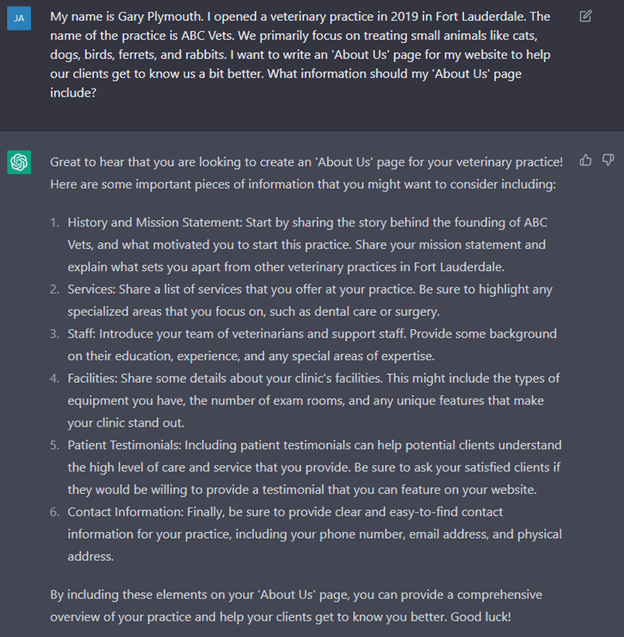
Looks pretty straightforward. Our About Us page doesn’t necessarily have to include all this information, but it does provide a good starting point. In fact, it reminds us of something - we never did get around to establishing a formal mission statement. Maybe ChatGPT can help out here, too.
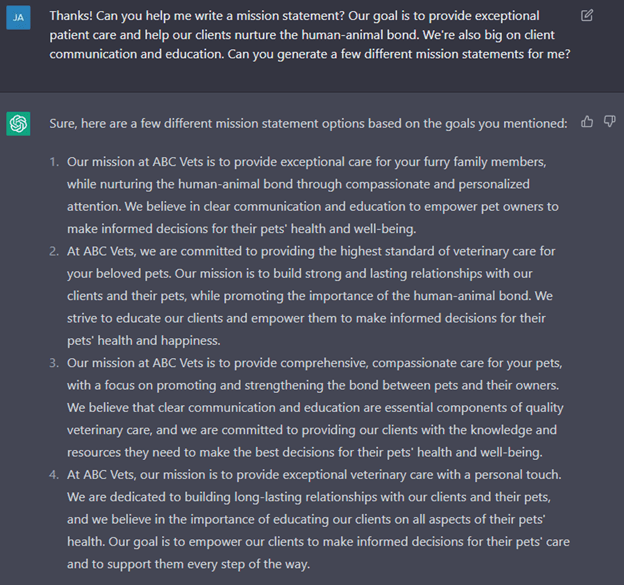
Eh. These examples are okay, but they’re a bit too wordy for our liking. Let’s ask for some more snappy examples.
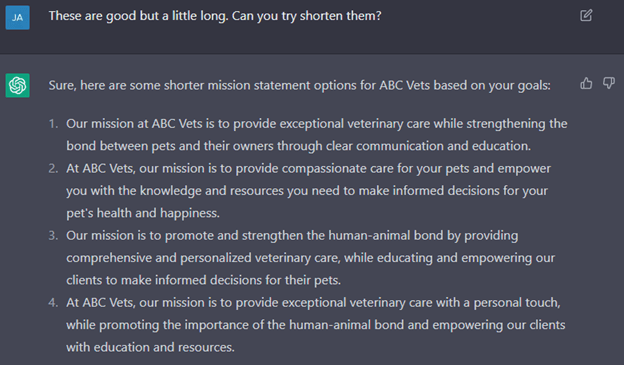
Much better. Let’s go with that first example.
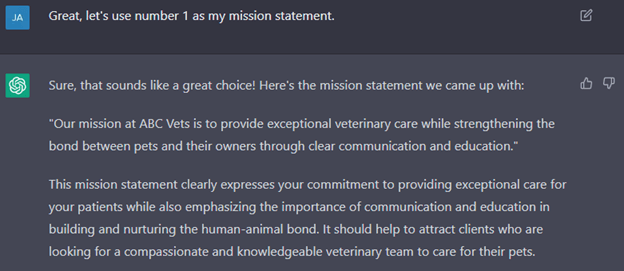
Okay, so we’ve got our mission statement locked in. ChatGPT did suggest creating some sections about our team and client testimonials, but let’s say we already have that content on other pages on our websites. What other content should be featured on our About Us page?
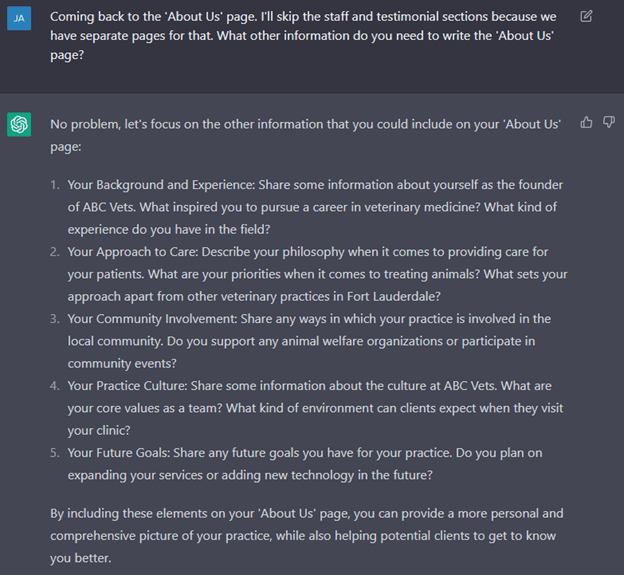
The more information we can provide, the more personalized ChatGPT’s outputs are. So, let’s take some time to feed it some information about our practice.

Now, let’s see what it comes up with.
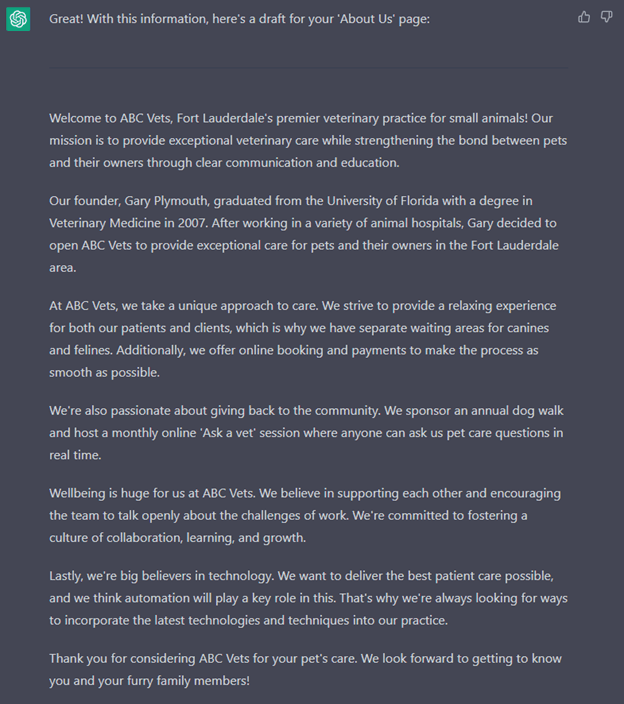
And there we have it. It’s not perfect, but it’s a solid foundation. With a few tweaks, it’ll be ready to be uploaded to our website.
2. Write a blog post
Okay, now let’s say that we want to start a new blog on our website. We’ve heard that maintaining a good blog can help us increase web traffic, drive social media engagement, and build our reputation as leaders in our field, but we’ve always been too busy to sit down and put pen to paper. Let’s see how ChatGPT can help us out.
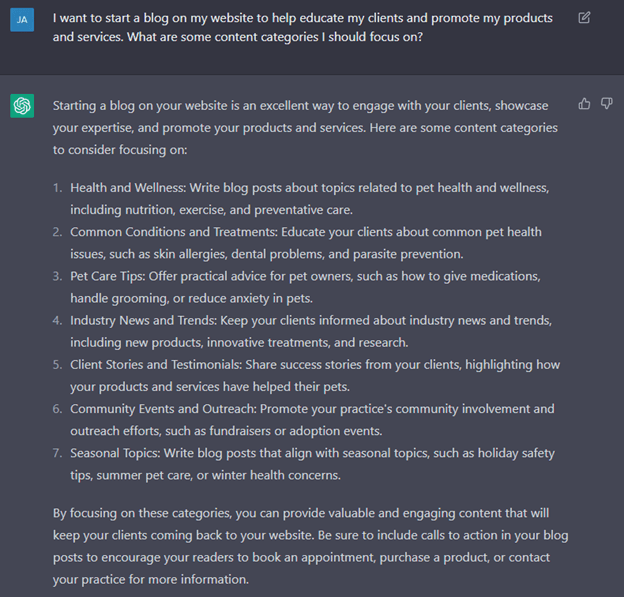
These all look like great ideas. With summer on the way, let’s see if we can drill down into number seven and generate some specific seasonal blog post topics.
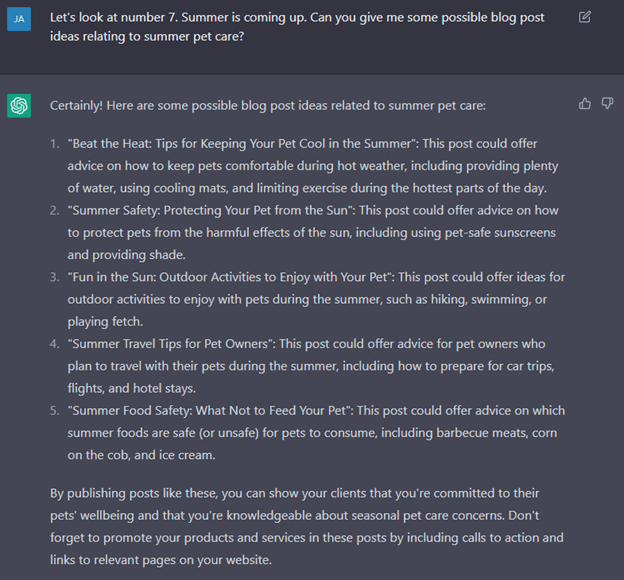
That first idea isn’t particularly unique, but it does cover a very common concern that many pet parents have. It will also be a good resource to be able to point clients to as the weather starts to heat up. Let’s see what ChatGPT can put together.
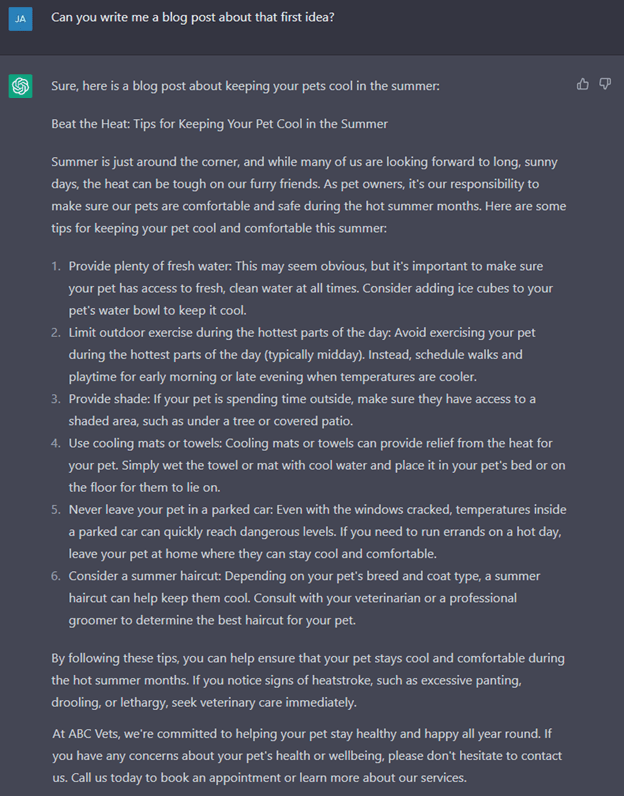
As with all ChatGPT outputs, it’s important to review the content and ensure that it’s all factually correct. This is particularly true when it comes to giving pet healthcare advice!
Back to the blog post. It all checks out, but that title isn’t particularly catchy. Let’s cook up a few more ideas.
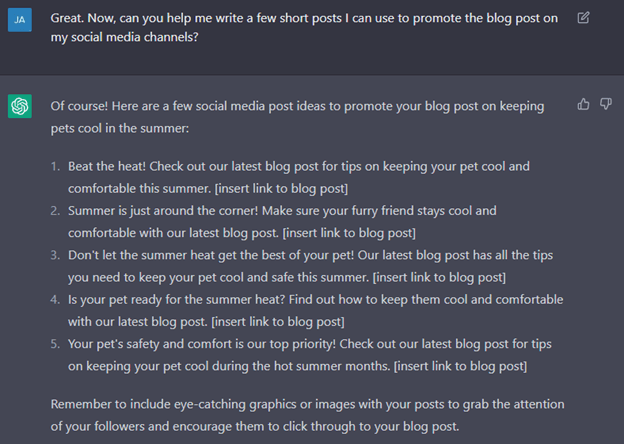
Let’s go with the fifth option. Now that we’ve created the blog post, it’s time to think about promoting it on social media.

In a matter of minutes, we've produced a blog post that's relevant and helpful to our client base and generated a bunch of social media posts we can use to promote the content. Easy!
3. Write a video script
The veterinary world lends itself well to visual content - after all, who doesn’t love to see a bunch of cute animals all over their social media feeds? However, it can be tricky to find the time to sit down and come up with ideas and then bring those ideas to life. Let’s see how we can use ChatGPT to help us streamline the video production process.
Let’s start by feeding ChatGPT some context about our audience and what we’re trying to achieve.
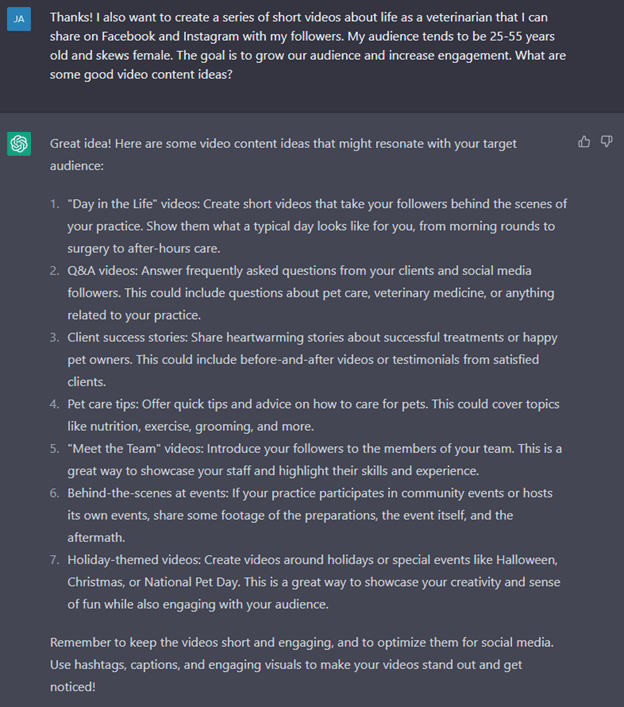
All of these content ideas are a good fit for our business. For now, let’s explore the fourth idea and see where it takes us.
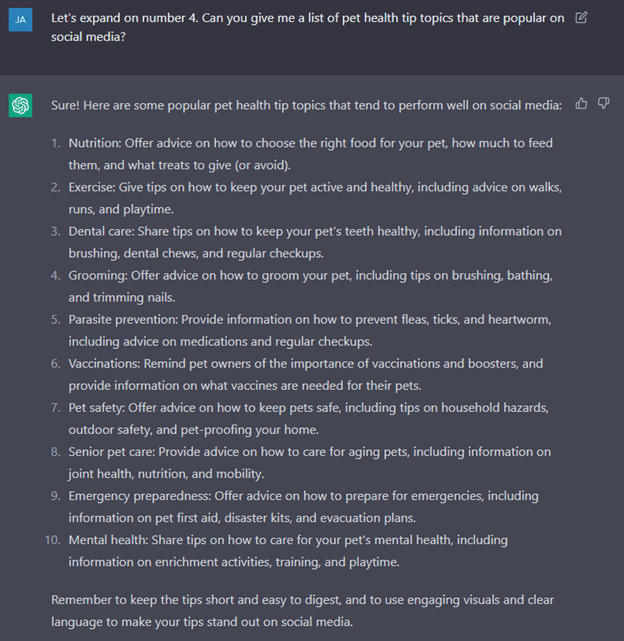
Dental care is always a popular topic. Let’s peel back another layer and get some specific video title ideas.
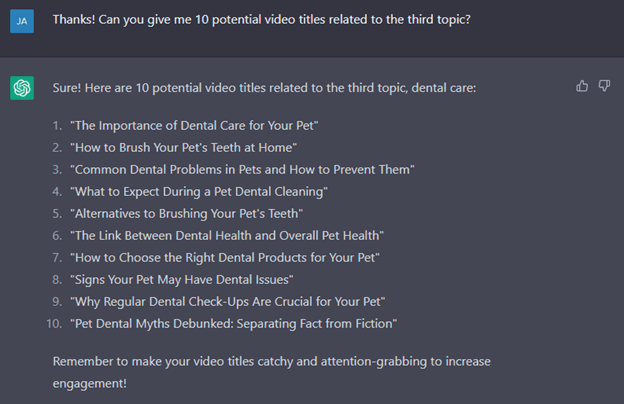
Of course, just about any veterinarian could stand up and give a 30-minute impromptu presentation on any of these topics. But that’s not the purpose of this video. We’re going for snappy, attention-grabbing, social media-friendly content. Hopefully, ChatGPT can whip us up a script that’ll help us keep the video short and sweet.
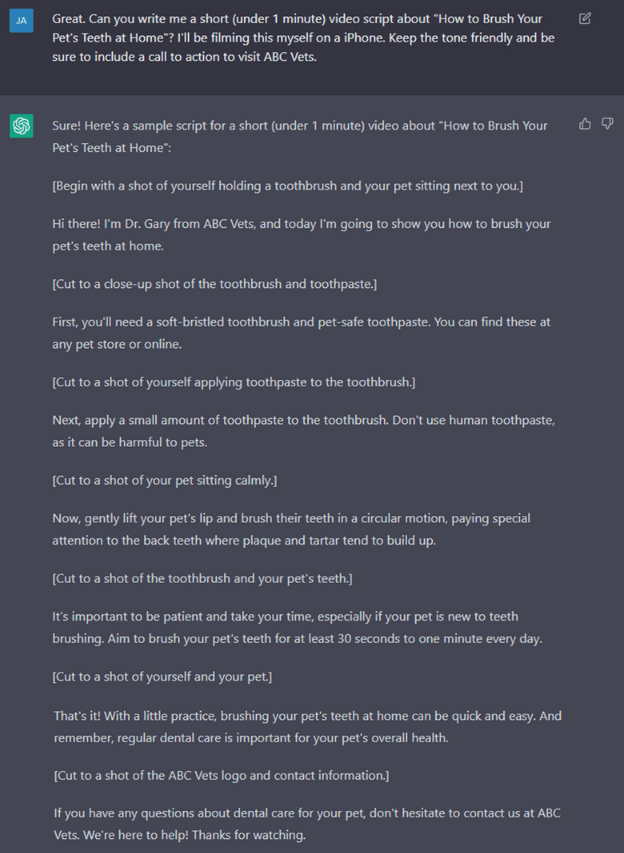
And now we have a script. It’s not going to be the most riveting video the internet’s ever seen, but it’s concise, to the point, and the perfect starting point for creating more in-depth videos further down the track if we want to.
4. Write an email newsletter
The humble newsletter remains one of the most effective ways of keeping in touch with our client base and promoting our products and services.
Let’s say that we’ve recently renovated our boarding kennel. To get the word out, we want to send an email to our clients, along with a 10% discount if they make a booking during May. Writing this email from scratch wouldn’t take long, but we can save some time by getting ChatGPT to do most of the heavy lifting for us.
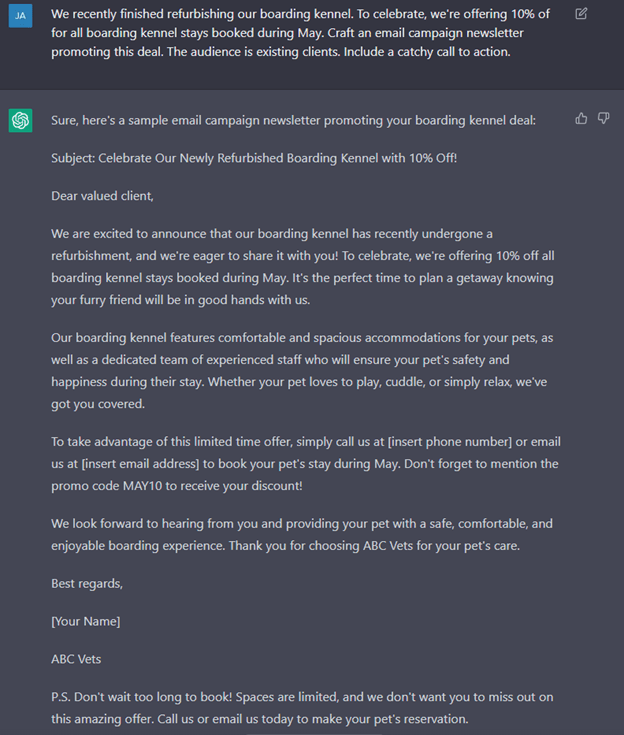
Not bad! However, the tone of the email is a little stiff and doesn’t reflect the friendly vibe we’re trying to portray at ABC Vets. Additionally, the postscript reads overly salesy for our liking. Let’s get rid of that.

The email’s shaping up nicely. However, we’re not fully sold on the subject line. Maybe ChatGPT has some other options for us.
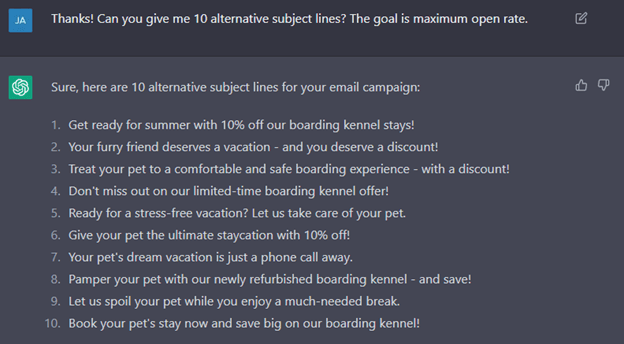
Number six is a good mix of informative, cute, and enticing - we’ll roll with that one for our email campaign.
5. Create a social media calendar
All right, now let’s say that we want to get serious about social media. Historically, we’ve taken a fairly ad hoc approach. We’ve been posting content somewhat regularly, but we haven’t put a lot of thought into it. Now, we want to be a bit more strategic. We’ve heard that a social media calendar is a good starting point, but we don’t really know what it is - much less how to make one. Let’s see what ChatGPT has to say.
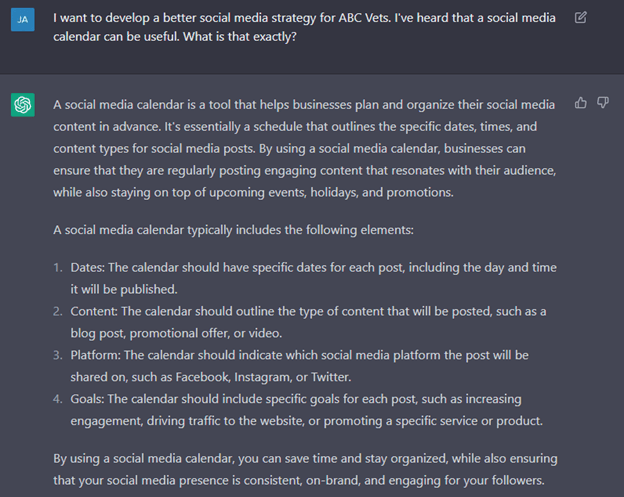
That all makes sense. But we don’t have time to sketch out a full social media calendar. Can ChatGPT give us a hand?
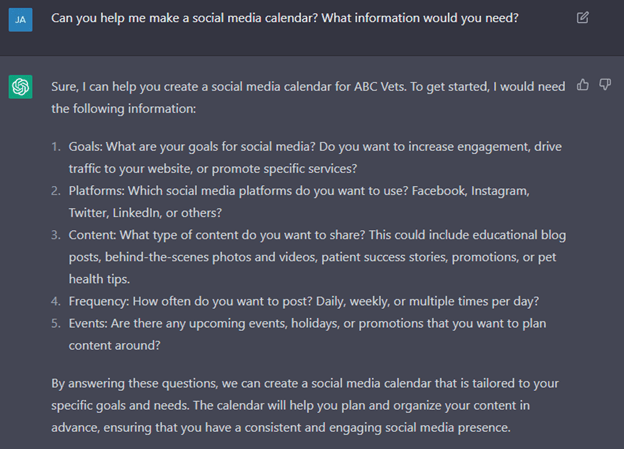
Again, providing context is key to getting quality outputs. Let’s give ChatGPT some brief insight into our goals and the type of content we want to focus on.

And here’s what ChatGPT spits out, all wrapped up in a nicely formatted table.
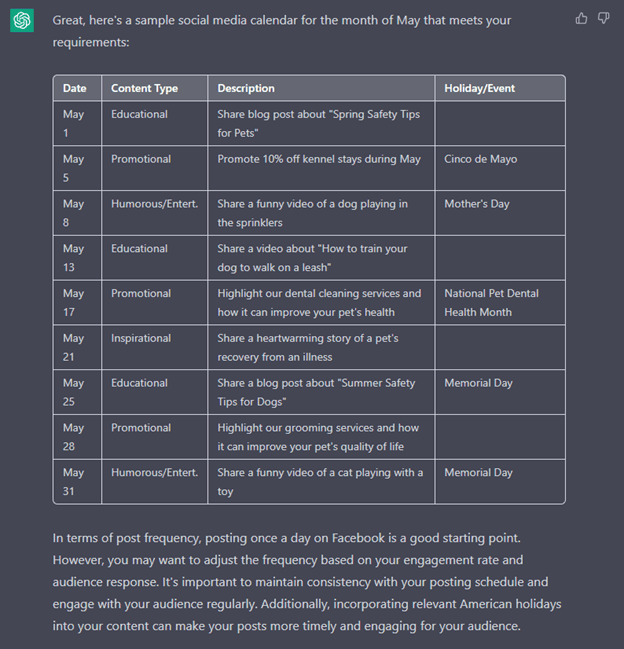
According to ChatGPT, posting daily on Facebook is ideal. So, let’s ask it to up the post frequency and create some posts to promote the content we created earlier.
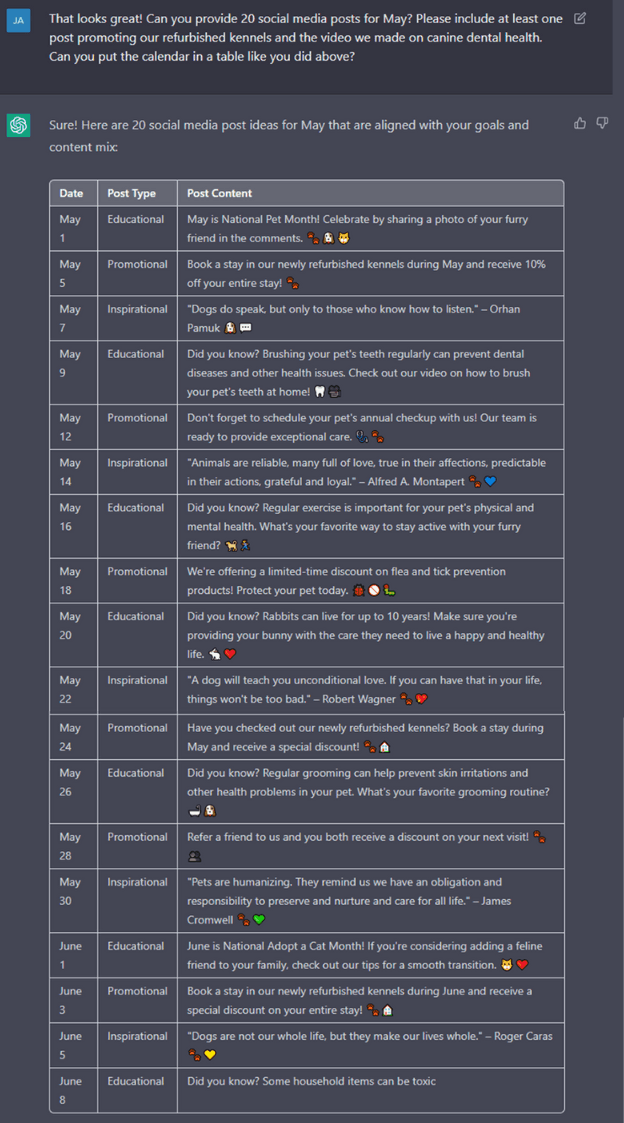
There are definitely some good ideas here that we can use. The inclusion of animal-themed holidays like National Pet Month and Adopt a Cat Month is a particularly nice touch.
But they’re not all winners. For example, the June 3 post promotes our boarding kennel discount, but earlier we mentioned that the promotion would only apply to bookings made in May. This underscores the importance of something we’ve said a few times by now: you must fact check the outputs!
How to get the best results from ChatGPT
- Review, review, review: ChatGPT is good but it’s not perfect. It frequently gets things wrong. It doesn't have access to real-time information and generally lacks knowledge of events that occurred after its data cutoff date of September 2021. It’s essential that you review all outputs to ensure that they’re factual and accurate, particularly when the content relates to pet healthcare advice.
- Stay on brand: While ChatGPT can - with enough feedback - get pretty close to emulating your communication style, it can’t capture it perfectly. Take the time to review all outputs and ensure they align with the tone and voice of your brand. Check out our Ultimate Guide to Veterinary Marketing for more information on creating an unforgettable veterinary brand!
- Be specific: When asking a question or making a statement, be as clear and specific as possible. The more information you provide, the better ChatGPT will be able to understand your request and provide an accurate response.
- Stay on topic: ChatGPT can get lost when you jump around from topic to topic. For best results, keep the conversation focused and open a new chat when you want to move onto a different subject.
- Use proper grammar and spelling: ChatGPT is trained to understand and generate natural language. Using proper grammar and spelling will help ChatGPT better understand your questions and provide more accurate responses.
- Give feedback: If ChatGPT's response is not what you were expecting or doesn't fully answer your question, give feedback by asking a follow-up question or providing more information. This will help ChatGPT learn and improve its responses over time.
Takeaway
In the fast-paced world of veterinary medicine, marketing activities are often relegated to the bottom of the to-do list as patient care takes the number one priority (and rightfully so!).
But it doesn’t have to be an either-or situation. By tapping into ChatGPT, you can greatly streamline production, allowing you to increase your marketing activity and scale-up content output without diverting precious time and resources from the work that needs your attention the most: your patients.
ChatGPT and other AI technologies are changing the way the world works. It's time for veterinary practices to embrace this innovative tool and reap the benefits of its time-saving capabilities.
Ready to save even more time on your daily processes? Book a demo with ezyVet and find out how our innovative software can help your veterinary practice function more efficiently.